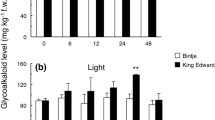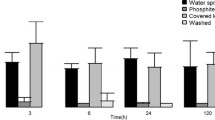Abstract
Exposure of potato tuber tissues to Phytophthora infestans, the late blight pathogen, elicits multiple defense responses, including an oxidative burst, accumulation of phenylpropanoid compounds, and sesquiterpenoid phytoalexins (lubimin and rishitin), which are accompanied by de novo synthesis of the enzymes that produce them. These reactions are also induced in potato tubers treated with a crude elicitor (hyphal wall components, or HWC) prepared from the mycelia of the pathogen. Differential hybridization was used to identify elicitor-responsive cDNAs from potato tubers. Database searches revealed that these genes appear to encode tyramine hydroxycinnamoyl transferase, arginine decarboxylase, glucose 6-phosphate dehydrogenase, 3-deoxy-d-arabino-heptulosonate 7-phosphate synthase, NADP-dependent malic enzyme, pyruvate decarboxylase, and other potential defense components. RNA gel blot analyses indicated that the accumulation of transcripts related to both secondary and primary metabolism was induced by the HWC elicitor, arachidonic acid or salicylic acid. This suggests that the signals from the pathogen activate not only secondary metabolism but also the primary metabolism that supports the rapid expression of defense responses in potato tubers.
Similar content being viewed by others
Author information
Authors and Affiliations
Corresponding author
Rights and permissions
About this article
Cite this article
Nakane, E., Kawakita, K., Doke, N. et al. Elicitation of primary and secondary metabolism during defense in the potato. J Gen Plant Pathol 69, 378–384 (2003). https://doi.org/10.1007/s10327-003-0075-6
Received:
Accepted:
Issue Date:
DOI: https://doi.org/10.1007/s10327-003-0075-6




